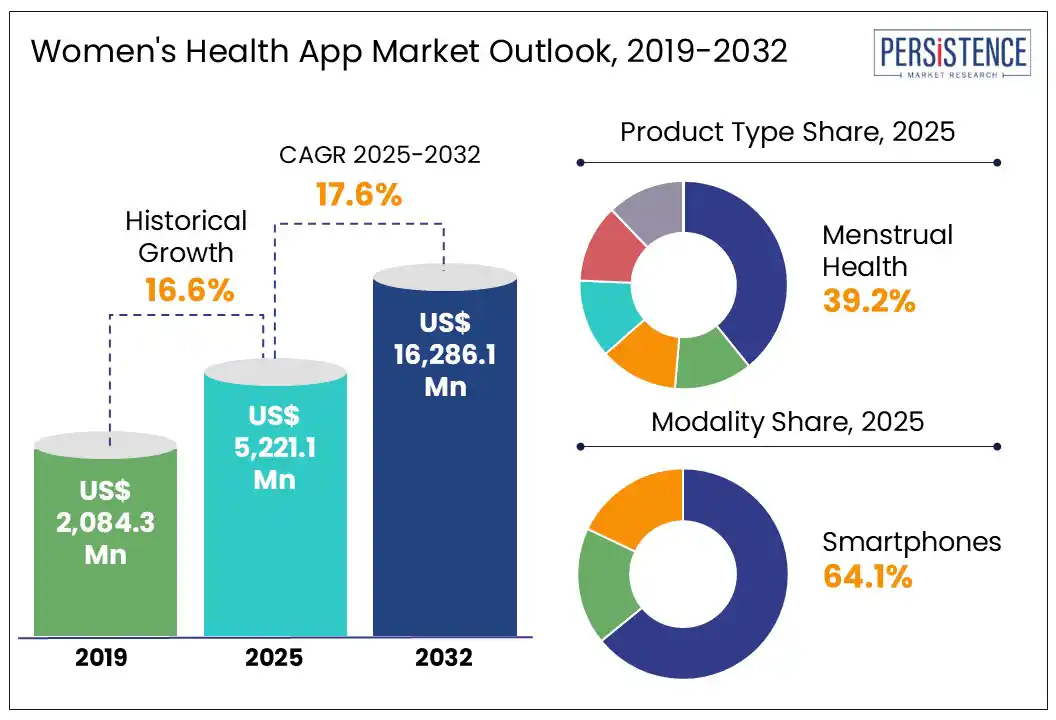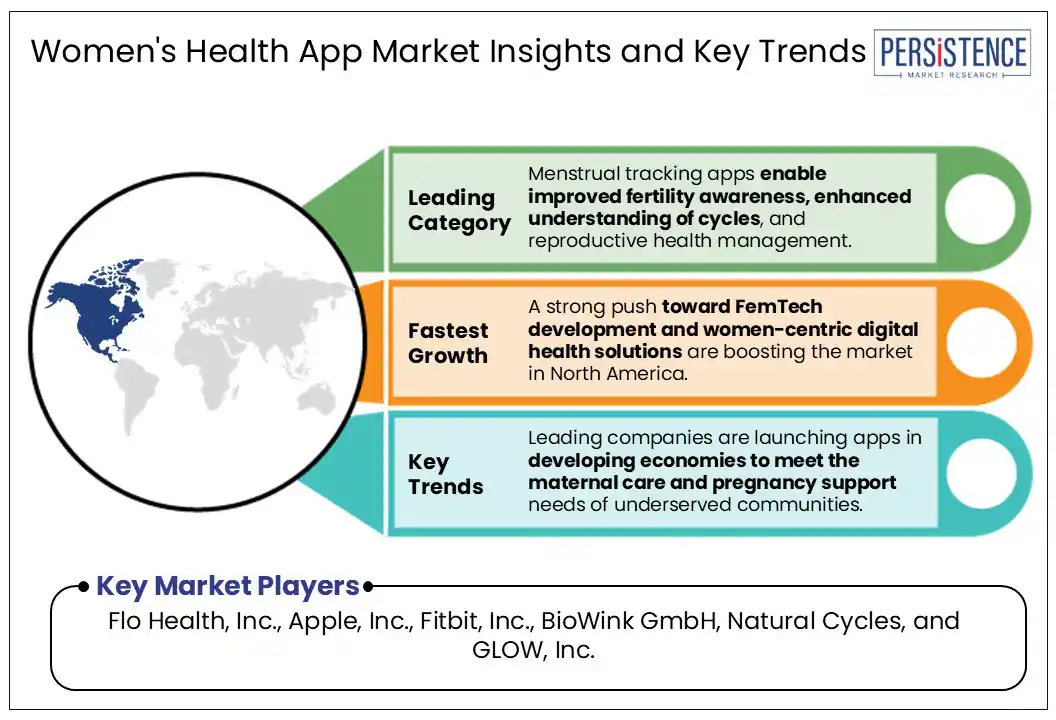ID: PMRREP35163| 194 Pages | 23 Jul 2025 | Format: PDF, Excel, PPT* | Healthcare

The global women’s health app market size is likely to be valued at US$ 5,221.1 Mn in 2025 and is estimated to reach US$ 16,286.1 Mn in 2032, growing at a CAGR of 17.6% during the forecast period 2025 - 2032. The women's health app market growth is driven by increasing health consciousness, technological innovations, and the integration of AI and data analytics into mobile health platforms.
Women's health apps are emerging as a game-changing force within the healthcare IT landscape. These digital tools empower women to take control of their overall health and wellness, addressing a wide spectrum of critical needs such as menopause management, breast health, fertility monitoring, pregnancy support, pelvic health, mental wellbeing, and personalized nutrition.

Key Industry Highlights
|
Global Market Attribute |
Key Insights |
|
Women’s Health App Market Size (2025E) |
US$ 5,221.1 Mn |
|
Market Value Forecast (2032F) |
US$ 16,286.1 Mn |
|
Projected Growth (CAGR 2025 to 2032) |
17.6% |
|
Historical Market Growth (CAGR 2019 to 2024) |
16.6% |
The women's health app market growth is being fueled by a heightening demand for personalized healthcare solutions and increasing investments in AI-powered health assistance platforms. Medical technology (MedTech) startups are prioritizing the development of solutions to address concerns surrounding data privacy, accessibility, and diagnostic accuracy, leading to the creation of safe, user-centric applications. Notable examples in this context include Ovum.AI, which raised nearly US$ 1.7 Mn in early 2025 to launch an AI-based health assistant tailored for women, featuring a specialized dataset and integrated medical records such as imaging and blood tests. Similarly, Comma, a female-founded company, secured US$ 2 Mn to launch Sara, a HIPAA-compliant period tracking app designed to protect user data. These developments reflect a broader shift in the burgeoning FemTech space, redefining the future of innovation in women’s health.
Privacy concerns are increasingly shaping the future of the adoption of women's health apps, as several of these apps have been found to collect a wide range of highly sensitive user data, such as menstrual cycles and pregnancy status. A study presented at the Conference on Human Factors in Computing Systems in Honolulu analyzed around 20 widely used apps from the U.K. and U.S. Google Play Store, uncovering troubling patterns such as misleading data deletion features, unstable privacy settings, and covert data collection practices. Some apps were even found to link user data with web browsing activity. These questionable design choices, also known as dark patterns, raise serious ethical concerns and may deter users from engaging with digital health platforms. However, the market is expected to evolve with the development of privacy-first FemTech apps that value data protection, user consent, and transparent privacy policies.
Governments are increasingly collaborating with private sector innovators to enhance access to digital healthcare solutions for women, particularly through investments in women’s health apps. A notable example is the U.K., which faces one of the widest gender health gaps among G20 nations. In February 2025, for instance, Curia hosted a parliamentary roundtable attended by Pharmaphorum, focusing on aligning with the Women’s Health Strategy for England to address long-standing disparities in women’s healthcare. One key initiative discussed at the event was the Cheshire Merseyside Women’s Health and Maternity (WHaM) App, developed by NHS Cheshire and Merseyside. This app provides expert-led, evidence-based content on topics such as fertility and conception, accessible in 75 languages via a regional content hub linked to Essential Parent. Such collaborations between government bodies, healthcare providers, and tech companies are expected to drive innovation and adoption in the digital women’s health market, promoting inclusivity, accessibility, and personalized care.
By product type, the women’s health app market has been segregated into menstrual health, menopause, pregnancy tracking & postpartum care, disease management, fitness & nutrition, and others. The menstrual health segment is projected to hold a 39.2% market share due to the ability of menstrual tracking apps to improve fertility awareness, enhance the understanding of individual cycles, and manage reproductive health.
Women's health apps, particularly menstrual tracking platforms such as Flo, Clue, and Period Tracker, have seen a surge in global adoption, with around 250 million downloads between April and December 2021. While most users are from the Global North, these apps have positive traction in the low-income countries. Various platforms are increasingly offering a range of free features to ensure accessibility in underserved regions with high fertility rates.
Menopause-focused apps are also gaining momentum, especially in developing countries where access to healthcare is limited. A notable example is Nawat, launched in March 2025 in Arab war zones, offering menopause-related resources. This trend highlights the expansion of this market, driven by demand for digital health solutions, FemTech innovation, and inclusive healthcare.
Based on modality, the market has been segmented into smartphones, tablets, and others. Of these, the smartphones category dominates this segment with a share of 64.1% in 2025 due to their seamless integration with wearables such as Oura Ring, Apple Watch, and Fitbit. These integrations enable real-time tracking of pregnancy symptoms, ovulation, and menstrual cycles. An excellent example in this context is Apple Health’s Cycle Tracking feature, launched in 2019, which uses AI to help users monitor and log reproductive health data.
Tablets follow as the second leading segment, preferred for their larger screens and enhanced usability. They are particularly effective for remote patient monitoring, virtual consultations, and accessing educational content, making women’s health apps a more immersive and engaging experience for users.

North America is projected to capture 36.8% of the women's health app market share in 2025, with the U.S. leading the region. Companies such as Allara Health are driving innovation through substantial funding. For instance, Allara secured US$ 26 Mn in Series B funding to expand its virtual care platform for hormonal conditions such as PCOS, hypothyroidism, and endometriosis. This reflects a strong push toward FemTech development and digital health solutions tailored to women's needs.
Canada is also advancing in women's health tech, particularly in areas such as contraception and pregnancy. In February 2025, for example, Reya Health launched a new app to guide users to select suitable birth control options. Available on Android and iOS, the app offers free access to users under employment insurance or student union plans. These developments fuel the region's shift toward women-centric personalized healthcare, and accessible mobile health platforms.
The Asia Pacific & Oceania region is making significant progress with China at the forefront on account of government initiatives such as Healthy China 2030. Popular women’s health apps such as Dayima and Meiyo, which integrate AI for menstrual tracking and personalized health insights, have attracted around 200 million users. These innovations signal a strong push toward smart healthcare and AI-powered FemTech in the region.
Australia features a highly regulated environment for data security and compliance through the Therapeutic Goods Administration (TGA). Apps such as Kindara and Ovulation Calendar Australia cater to pregnancy and fertility tracking. Meanwhile, Southeast Asian countries including the Philippines, Vietnam, Thailand, and Indonesia, present emerging opportunities in telehealth. Indonesia’s Halodoc is expanding its telehealth services to better serve women’s health needs, indicating a macro-regional shift toward accessible digital health platforms.
The market in Latin America is expanding at a healthy rate, with Brazil leading the pack through its Unified Health System (SUS), which promotes digital health integration. Popular apps such as Clue Brazil and FEMME offer teleconsultations, menstrual tracking, and pregnancy monitoring. A promising example is that of Plena, a Brazil-based health-tech startup, which secured over US$ 5 Mn in funding in November 2024 to enhance its virtual reproductive and sexual health services.
Mexico is also experiencing increased adoption of women’s health apps, mainly owing to digital maternal health initiatives by the Ministry of Health. Meanwhile, Argentina’s LUNA Argentina app attracted nearly 500,000 active users in 2024, offering free fertility prediction and cycle tracking. These trends highlight Latin America’s commitment to accessible mobile health platforms, reproductive health innovation, and AI-powered women's wellness solutions.
The global women's health app market is becoming increasingly dynamic, with companies of all shapes and sizes launching innovative solutions targeting menopause, PCOS, stress, and weight management. This surge in FemTech innovation reflects a concerted effort to not just tap into this lucrative space but address the critical health needs of women through technology.
Looking ahead, a wave of startups is expected to enter the market, often collaborating with different entities to raise funding and expedite regulatory approvals. Additionally, clinical studies are anticipated to accompany new app launches, ensuring their effectiveness and credibility. This trend underscores the growing emphasis on evidence-based digital health, public-private partnerships, and personalized wellness technologies for women.
The women’s health app market is projected to reach US$ 5,221.1 Mn in 2025.
The women’s health app market is poised to witness a CAGR of 17.6% from 2025 to 2032.
Growing demand for personalized healthcare solutions and increasing investments in AI-powered health assistance platforms for women are key market drivers.
Governments collaborating with private sector innovators to enhance access to digital healthcare solutions for women is a key market opportunity.
Flo Health, Inc., Apple, Inc., and Fitbit, Inc. are some of the key market players.
|
Report Attribute |
Details |
|
Historical Data/Actuals |
2019 - 2024 |
|
Forecast Period |
2025 - 2032 |
|
Market Analysis |
Value: US$ Mn |
|
Geographical Coverage |
|
|
Segmental Coverage |
|
|
Competitive Analysis |
|
|
Report Highlights |
|
|
Customization and Pricing |
Available upon request |
By Product Type
By Modality
By Region
Delivery Timelines
For more information on this report and its delivery timelines please get in touch with our sales team.
About Author